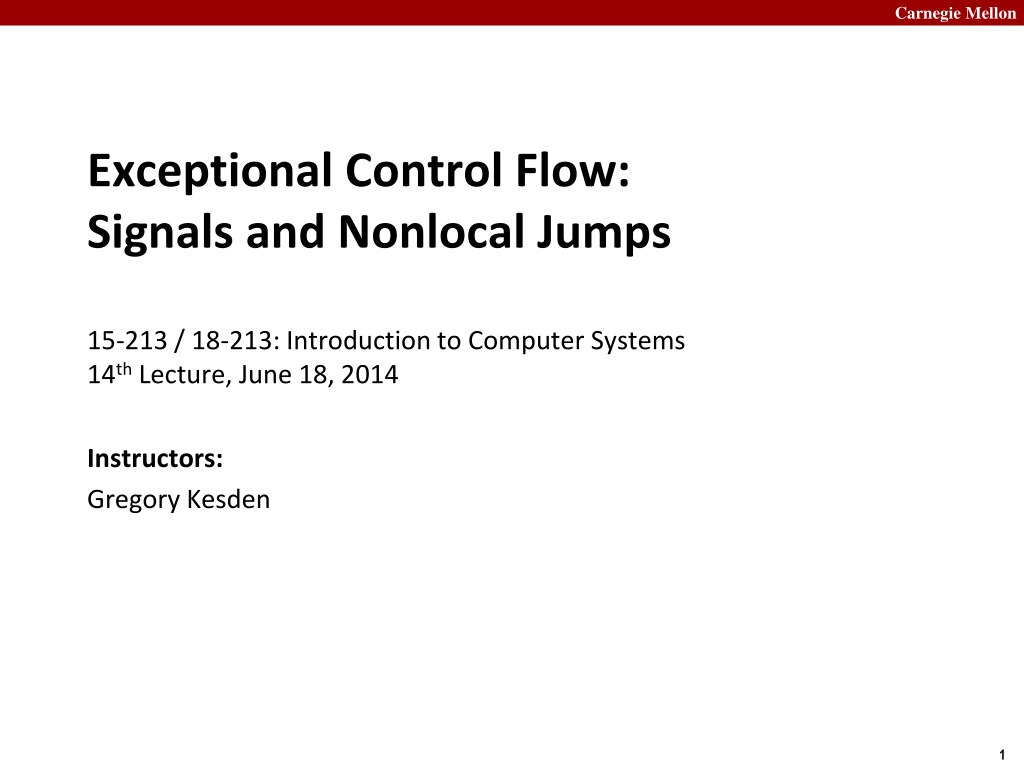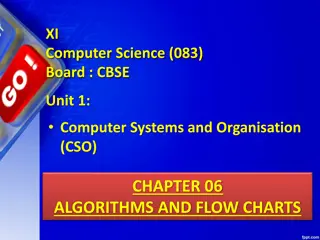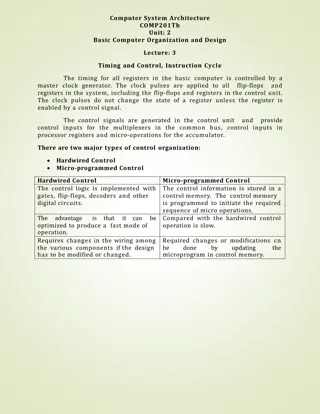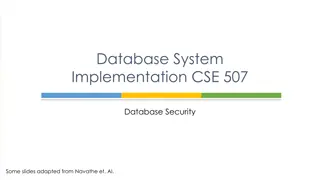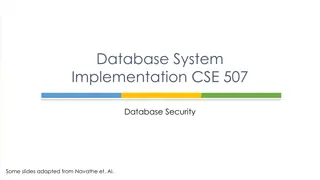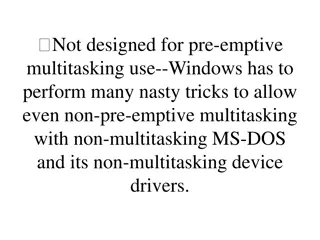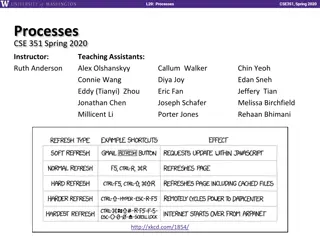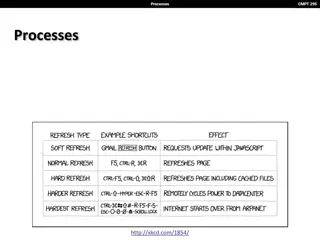Understanding Multitasking and Exceptional Control Flow in Computer Systems
Explore the intricacies of multitasking and exceptional control flow in computer systems as taught in Carnegie Mellon's 15-213/18-213 course. Delve into topics like signals, nonlocal jumps, bits, bytes, integers, floats, assembly, stack discipline, cache linking, process context switch, hardware timer, and more. Gain insights into how systems manage multiple processes simultaneously, the basics of forking processes, and the challenges programmers face in multitasking environments.
Download Presentation

Please find below an Image/Link to download the presentation.
The content on the website is provided AS IS for your information and personal use only. It may not be sold, licensed, or shared on other websites without obtaining consent from the author. Download presentation by click this link. If you encounter any issues during the download, it is possible that the publisher has removed the file from their server.
E N D
Presentation Transcript
Carnegie Mellon Exceptional Control Flow: Signals and Nonlocal Jumps 15-213 / 18-213: Introduction to Computer Systems 14thLecture, June 18, 2014 Instructors: Gregory Kesden 1
Carnegie Mellon Exam Next Week! Exam Format Designed for normal class period, we give you 4 hours You can bring 1 double-side notes sheet Take it in the comfort of a proctored computer cluster Tentative Test Taking Times (locations TBA) Monday 9-midnight Tuesday 9-midnight Wednesday 9-midnight Thursday 5pm-midnight Topics Include Bits, Bytes, Integers, Floats Assembly Stack Discipline Cache Linking 2
Carnegie Mellon ECF Exists at All Levels of a System Exceptions Hardware and operating system kernel software Previous Lecture Process Context Switch Hardware timer and kernel software Signals Kernel software and application software Nonlocal jumps Application code This Lecture 3
Carnegie Mellon Today Multitasking, shells Signals Nonlocal jumps 4
Carnegie Mellon The World of Multitasking System runs many processes concurrently Process: executing program State includes memory image + register values + program counter Regularly switches from one process to another Suspend process when it needs I/O resource or timer event occurs Resume process when I/O available or given scheduling priority Appears to user(s) as if all processes executing simultaneously Even though most systems can only execute one process at a time Except possibly with lower performance than if running alone 5
Carnegie Mellon Programmer s Model of Multitasking Basic functions forkspawns new process Called once, returns twice exitterminates own process Called once, never returns Puts it into zombie status waitand waitpidwait for and reap terminated children execveruns new program in existing process Called once, (normally) never returns Programming challenge Understanding the nonstandard semantics of the functions Avoiding improper use of system resources E.g. Fork bombs can disable a system 6
Carnegie Mellon Unix Process Hierarchy [0] init [1] Daemon e.g. httpd Login shell Child Child Child Grandchild Grandchild 7
Carnegie Mellon Shell Programs A shell is an application program that runs programs on behalf of the user. sh Original Unix shell (Stephen Bourne, AT&T Bell Labs, 1977) cshBSD Unix C shell (tcsh: enhanced csh at CMU and elsewhere) bash Bourne-Again Shell Execution is a sequence of read/evaluate steps int main() { char cmdline[MAXLINE]; while (1) { /* read */ printf("> "); Fgets(cmdline, MAXLINE, stdin); if (feof(stdin)) exit(0); } } /* evaluate */ eval(cmdline); 8
Carnegie Mellon Simple Shell eval Function void eval(char *cmdline) { char *argv[MAXARGS]; /* argv for execve() */ int bg; /* should the job run in bg or fg? */ pid_t pid; /* process id */ bg = parseline(cmdline, argv); if (!builtin_command(argv)) { if ((pid = Fork()) == 0) { /* child runs user job */ if (execve(argv[0], argv, environ) < 0) { printf("%s: Command not found.\n", argv[0]); exit(0); } } int status; } else /* otherwise, don t wait for bg job */ printf("%d %s", pid, cmdline); } } if (!bg) { /* parent waits for fg job to terminate */ if (waitpid(pid, &status, 0) < 0) unix_error("waitfg: waitpid error"); 9
Carnegie Mellon What Is a Background Job ? Users generally run one command at a time Type command, read output, type another command Some programs run for a long time Example: delete this file in two hours unix> sleep 7200; rm /tmp/junk # shell stuck for 2 hours A background job is a process we don't want to wait for unix> (sleep 7200 ; rm /tmp/junk) & [1] 907 unix> # ready for next command 10
Carnegie Mellon Problem with Simple Shell Example Our example shell correctly waits for and reaps foreground jobs But what about background jobs? Will become zombies when they terminate Will never be reaped because shell (typically) will not terminate Will create a memory leak that could run the kernel out of memory Modern Unix: once you exceed your process quota, your shell can't run any new commands for you: fork() returns -1 unix> limit maxproc # csh syntax maxproc 202752 unix> ulimit -u # bash syntax 202752 11
Carnegie Mellon ECF to the Rescue! Problem The shell doesn't know when a background job will finish By nature, it could happen at any time The shell's regular control flow can't reap exited background processes in a timely fashion Regular control flow is wait until running job completes, then reap it Solution: Exceptional control flow The kernel will interrupt regular processing to alert us when a background process completes In Unix, the alert mechanism is called a signal 12
Carnegie Mellon Today Multitasking, shells Signals Nonlocal jumps 13
Carnegie Mellon Signals A signal is a small message that notifies a process that an event of some type has occurred in the system akin to exceptions and interrupts sent from the kernel (sometimes at the request of another process) to a process signal type is identified by small integer ID s (1-30) only information in a signal is its ID and the fact that it arrived ID Name Default Action Corresponding Event 2 SIGINT Terminate Interrupt (e.g., ctl-c from keyboard) 9 SIGKILL Terminate Kill program (cannot override or ignore) 11 SIGSEGV Terminate & Dump Segmentation violation 14 SIGALRM Terminate Timer signal 17 SIGCHLD Ignore Child stopped or terminated 14
Carnegie Mellon Sending a Signal Kernel sends (delivers) a signal to a destination process by updating some state in the context of the destination process Kernel sends a signal for one of the following reasons: Kernel has detected a system event such as divide-by-zero (SIGFPE) or the termination of a child process (SIGCHLD) Another process has invoked the kill system call to explicitly request the kernel to send a signal to the destination process 15
Carnegie Mellon Receiving a Signal A destination process receives a signal when it is forced by the kernel to react in some way to the delivery of the signal Three possible ways to react: Ignore the signal (do nothing) Terminate the process (with optional core dump) Catchthe signal by executing a user-level function called signal handler Akin to a hardware exception handler being called in response to an asynchronous interrupt 16
Carnegie Mellon Pending and Blocked Signals A signal is pending if sent but not yet received There can be at most one pending signal of any particular type Important: Signals are not queued If a process has a pending signal of type k, then subsequent signals of type k that are sent to that process are discarded A process can block the receipt of certain signals Blocked signals can be delivered, but will not be received until the signal is unblocked A pending signal is received at most once 17
Carnegie Mellon Signal Concepts Kernel maintains pending and blocked bit vectors in the context of each process pending: represents the set of pending signals Kernel sets bit k in pending when a signal of type k is delivered Kernel clears bit k in pending when a signal of type k is received blocked: represents the set of blocked signals Can be set and cleared by using the sigprocmask function 18
Carnegie Mellon Process Groups Every process belongs to exactly one process group pid=10 pgid=10 Shell Back- ground job #1 Fore- ground job Back- ground job #2 pid=20 pgid=20 pid=32 pgid=32 pid=40 pgid=40 Background process group 32 Background process group 40 Child Child getpgrp() Return process group of current process pid=21 pgid=20 pid=22 pgid=20 Foreground process group 20 setpgid() Change process group of a process 19
Carnegie Mellon Sending Signals with /bin/kill Program /bin/kill program sends arbitrary signal to a process or process group linux> ./forks 16 Child1: pid=24818 pgrp=24817 Child2: pid=24819 pgrp=24817 linux> ps PID TTY TIME CMD 24788 pts/2 00:00:00 tcsh 24818 pts/2 00:00:02 forks 24819 pts/2 00:00:02 forks 24820 pts/2 00:00:00 ps linux> /bin/kill -9 -24817 linux> ps PID TTY TIME CMD 24788 pts/2 00:00:00 tcsh 24823 pts/2 00:00:00 ps linux> Examples /bin/kill 9 24818 Send SIGKILL to process 24818 /bin/kill 9 24817 Send SIGKILL to every process in process group 24817 20
Carnegie Mellon Sending Signals from the Keyboard Typing ctrl-c (ctrl-z) sends a SIGINT (SIGTSTP) to every job in the foreground process group. SIGINT default action is to terminate each process SIGTSTP default action is to stop (suspend) each process pid=10 pgid=10 Shell Back- ground job #1 Fore- ground job Back- ground job #2 pid=20 pgid=20 pid=32 pgid=32 pid=40 pgid=40 Background process group 32 Background process group 40 Child Child pid=21 pgid=20 pid=22 pgid=20 Foreground process group 20 21
Carnegie Mellon Example of ctrl-c and ctrl-z STAT (process state) Legend: bluefish> ./forks 17 Child: pid=28108 pgrp=28107 Parent: pid=28107 pgrp=28107 <types ctrl-z> Suspended bluefish> ps w PID TTY STAT TIME COMMAND 27699 pts/8 Ss 0:00 -tcsh 28107 pts/8 T 0:01 ./forks 17 28108 pts/8 T 0:01 ./forks 17 28109 pts/8 R+ 0:00 ps w bluefish> fg ./forks 17 <types ctrl-c> bluefish> ps w PID TTY STAT TIME COMMAND 27699 pts/8 Ss 0:00 -tcsh 28110 pts/8 R+ 0:00 ps w First letter: S: sleeping T: stopped R: running Second letter: s: session leader +: foreground proc group See man ps for more details 22
Carnegie Mellon Sending Signals with kill Function void fork12() { pid_t pid[N]; int i, child_status; for (i = 0; i < N; i++) if ((pid[i] = fork()) == 0) while(1); /* Child infinite loop */ /* Parent terminates the child processes */ for (i = 0; i < N; i++) { printf("Killing process %d\n", pid[i]); kill(pid[i], SIGINT); } /* Parent reaps terminated children */ for (i = 0; i < N; i++) { pid_t wpid = wait(&child_status); if (WIFEXITED(child_status)) printf("Child %d terminated with exit status %d\n", wpid, WEXITSTATUS(child_status)); else printf("Child %d terminated abnormally\n", wpid); } } 23
Carnegie Mellon Receiving Signals Suppose kernel is returning from an exception handler and is ready to pass control to process p Process A Process B user code context switch kernel code Time user code context switch kernel code user code Important: All context switches are initiated by calling some exceptional hander. 24
Carnegie Mellon Receiving Signals Suppose kernel is returning from an exception handler and is ready to pass control to process p Kernel computes pnb = pending & ~blocked The set of pending nonblocked signals for process p If (pnb == 0) Pass control to next instruction in the logical flow for p Else Choose least nonzero bit k in pnband force process p to receive signal k The receipt of the signal triggers some action by p Repeat for all nonzero k in pnb Pass control to next instruction in logical flow for p 25
Carnegie Mellon Default Actions Each signal type has a predefined default action, which is one of: The process terminates The process terminates and dumps core The process stops until restarted by a SIGCONT signal The process ignores the signal 26
Carnegie Mellon Installing Signal Handlers The signal function modifies the default action associated with the receipt of signal signum: handler_t *signal(int signum, handler_t *handler) Different values for handler: SIG_IGN: ignore signals of type signum SIG_DFL: revert to the default action on receipt of signals of type signum Otherwise, handler is the address of a signal handler Called when process receives signal of type signum Referred to as installing the handler Executing handler is called catching or handling the signal When the handler executes its return statement, control passes back to instruction in the control flow of the process that was interrupted by receipt of the signal 27
Carnegie Mellon Signal Handling Example void int_handler(int sig) { safe_printf("Process %d received signal %d\n", getpid(), sig); exit(0); } void fork13() { pid_t pid[N]; int i, child_status; signal(SIGINT, int_handler); for (i = 0; i < N; i++) if ((pid[i] = fork()) == 0) { while(1); /* child infinite loop } for (i = 0; i < N; i++) { printf("Killing process %d\n", pid[i]); kill(pid[i], SIGINT); } for (i = 0; i < N; i++) { pid_t wpid = wait(&child_status); if (WIFEXITED(child_status)) printf("Child %d terminated with exit status %d\n", wpid, WEXITSTATUS(child_status)); else printf("Child %d terminated abnormally\n", wpid); } } linux> ./forks 13 Killing process 25417 Killing process 25418 Killing process 25419 Killing process 25420 Killing process 25421 Process 25417 received signal 2 Process 25418 received signal 2 Process 25420 received signal 2 Process 25421 received signal 2 Process 25419 received signal 2 Child 25417 terminated with exit status 0 Child 25418 terminated with exit status 0 Child 25420 terminated with exit status 0 Child 25419 terminated with exit status 0 Child 25421 terminated with exit status 0 linux> 28
Carnegie Mellon Signals Handlers as Concurrent Flows A signal handler is a separate logical flow (not process) that runs concurrently with the main program concurrently in the not sequential sense Process A Process A Process B while (1) ; handler(){ } Time 29
Carnegie Mellon Another View of Signal Handlers as Concurrent Flows Process A Process B user code (main) Signal delivered Icurr context switch kernel code user code (main) context switch kernel code Signal received user code (handler) kernel code Inext user code (main) 30
Carnegie Mellon Signal Handler Funkiness Pending signals are not queued For each signal type, just have single bit indicating whether or not signal is pending int ccount = 0; void child_handler(int sig) { int child_status; pid_t pid = wait(&child_status); ccount--; safe_printf( "Received signal %d from process %d\n", sig, pid); } Even if multiple processes have sent this signal void fork14() { pid_t pid[N]; int i, child_status; ccount = N; signal(SIGCHLD, child_handler); for (i = 0; i < N; i++) if ((pid[i] = fork()) == 0) { sleep(1); /* deschedule child */ exit(0); /* Child: Exit */ } while (ccount > 0) pause(); /* Suspend until signal occurs */ } linux> ./forks 14 Received SIGCHLD signal 17 for process 21344 Received SIGCHLD signal 17 for process 21345 31
Carnegie Mellon Living With Nonqueuing Signals Must check for all terminated jobs Typically loop with waitpid void child_handler2(int sig) { int child_status; pid_t pid; while ((pid = waitpid(-1, &child_status, WNOHANG)) > 0) { ccount--; safe_printf("Received signal %d from process %d\n", sig, pid); } } greatwhite> forks 15 Received signal 17 from process 27476 Received signal 17 from process 27477 Received signal 17 from process 27478 Received signal 17 from process 27479 Received signal 17 from process 27480 greatwhite> void fork15() { . . . signal(SIGCHLD, child_handler2); . . . } 32
Carnegie Mellon More Signal Handler Funkiness Signal arrival during long system calls (say a read) Signal handler interrupts read call Linux: upon return from signal handler, the read call is restarted automatically Some other flavors of Unix can cause the read call to fail with an EINTRerror number (errno) in this case, the application program can restart the slow system call Subtle differences like these complicate the writing of portable code that uses signals Consult your textbook for details 33
Carnegie Mellon A Program That Reacts to Externally Generated Events (Ctrl-c) #include <stdlib.h> #include <stdio.h> #include <signal.h> void handler(int sig) { safe_printf("You think hitting ctrl-c will stop the bomb?\n"); sleep(2); safe_printf("Well..."); sleep(1); printf("OK\n"); exit(0); } main() { signal(SIGINT, handler); /* installs ctl-c handler */ while(1) { } } external.c linux> ./external <ctrl-c> You think hitting ctrl-c will stop the bomb? Well...OK linux> 34
Carnegie Mellon A Program That Reacts to Internally Generated Events #include <stdio.h> #include <signal.h> int beeps = 0; /* SIGALRM handler */ void handler(int sig) { safe_printf("BEEP\n"); if (++beeps < 5) alarm(1); else { safe_printf("BOOM!\n"); exit(0); } } main() { signal(SIGALRM, handler); alarm(1); /* send SIGALRM in 1 second */ while (1) { /* handler returns here */ } } linux> ./internal BEEP BEEP BEEP BEEP BEEP BOOM! bass> internal.c 35
Carnegie Mellon Async-Signal-Safety Function is async-signal-safe if either reentrant (all variables stored on stack frame, CS:APP2e 12.7.2) or non-interruptible by signals. Posix guarantees 117 functions to be async-signal-safe write is on the list, printf is not One solution: async-signal-safe wrapper for printf: void safe_printf(const char *format, ...) { char buf[MAXS]; va_list args; va_start(args, format); /* reentrant */ vsnprintf(buf, sizeof(buf), format, args); /* reentrant */ va_end(args); /* reentrant */ write(1, buf, strlen(buf)); /* async-signal-safe */ } safe_printf.c 36
Carnegie Mellon Today Multitasking, shells Signals Nonlocal jumps 37
Carnegie Mellon Nonlocal Jumps: setjmp/longjmp Powerful (but dangerous) user-level mechanism for transferring control to an arbitrary location Controlled way to break the procedure call / return discipline Useful for error recovery and signal handling int setjmp(jmp_buf j) Must be called before longjmp Identifies a return site for a subsequent longjmp Called once, returns one or more times Implementation: Remember where you are by storing the current register context, stack pointer, and PC value in jmp_buf Return 0 38
Carnegie Mellon setjmp/longjmp (cont) void longjmp(jmp_buf j, int i) Meaning: return from the setjmp remembered by jump buffer j again ... this time returningi instead of 0 Called after setjmp Called once, but never returns longjmp Implementation: Restore register context (stack pointer, base pointer, PC value) from jump buffer j Set %eax(the return value) to i Jump to the location indicated by the PC stored in jump buf j 39
Carnegie Mellon setjmp/longjmp Example #include <setjmp.h> jmp_buf buf; main() { if (setjmp(buf) != 0) { printf("back in main due to an error\n"); else printf("first time through\n"); p1(); /* p1 calls p2, which calls p3 */ } ... p3() { <error checking code> if (error) longjmp(buf, 1) } 40
Carnegie Mellon Limitations of Nonlocal Jumps Works within stack discipline Can only long jump to environment of function that has been called but not yet completed Before longjmp After longjmp env jmp_buf env; P1 P1 P1() { if (setjmp(env)) { /* Long Jump to here */ } else { P2(); } } P2 P2 P2 P2() { . . . P2(); . . . P3(); } P3 P3() { longjmp(env, 1); } 41
Carnegie Mellon Limitations of Long Jumps (cont.) Works within stack discipline Can only long jump to environment of function that has been called but not yet completed P1 jmp_buf env; P1() { P2(); P3(); } P2 env At setjmp P1 P2() { if (setjmp(env)) { /* Long Jump to here */ } } env P2 X P2 returns P1 P3() { longjmp(env, 1); } env P3 X At longjmp 42
Carnegie Mellon Putting It All Together: A Program That Restarts Itself When ctrl-c d #include <stdio.h> #include <signal.h> #include <setjmp.h> greatwhite> ./restart starting processing... processing... processing... restarting processing... processing... restarting processing... processing... processing... sigjmp_buf buf; void handler(int sig) { siglongjmp(buf, 1); } main() { signal(SIGINT, handler); if (!sigsetjmp(buf, 1)) printf("starting\n"); else printf("restarting\n"); Ctrl-c Ctrl-c while(1) { sleep(1); printf("processing...\n"); } } restart.c 43
Carnegie Mellon Summary Signals provide process-level exception handling Can generate from user programs Can define effect by declaring signal handler Some caveats Very high overhead >10,000 clock cycles Only use for exceptional conditions Don t have queues Just one bit for each pending signal type Nonlocal jumps provide exceptional control flow within process Within constraints of stack discipline 44
